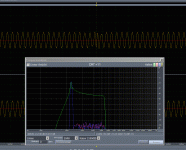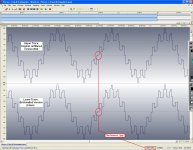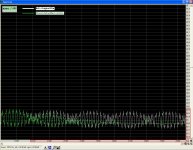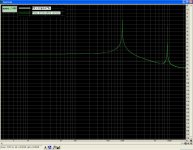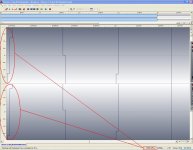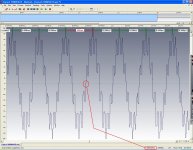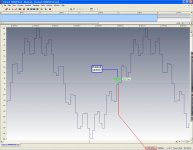If I'm reading this correctly, we're seeing a result of an "illegal value" sample. These can occur in artificially generated or in processed wav files. DAW's for example have to include low pass filtering in their outputs for this reason. This is just another way of stating what Scott Wurcer said and his example shows it more clearly, a step change from razor blade editing.
Thanks,
Chris
Thanks,
Chris
Simon7000's 9kHz blip exposed
Good Morning,
I fiddled around a bit with Ed's "nyquist buster" and have to say from listening impression and signal analysis I'm tempted to have another opionion about what we actually do hear as the dominant effect (the blip at centertime).
What I did :
- upsampling to 176.4k and back (high precision, in Audition), gave the expected result, slightly different sample values around the blip coming from the brickwall, also seen in the spot FFT.
- there was no difference in sound when playing back the original and the brickwalled version (maybe not finally conclusive, though).
- to better audition the blip I overrode the sample rate of 176.4k with 44.1k (times 4 pitch downshift), it sounded exactly the same, just everything lower in pitch.
- next I filtered this with a 16th-order linear phase linkwitz-riley highpass @ HF tone (which is @2250Hz now), the effect can be seen in the attachment and it also sounds like this, the blip, now with symmetrical moderate ringing from the filter.
In my opinion we only hear the result of the phase shift from the discontinuity, there also might be a standing wave pattern issue in the ear canal resonances, too (I have experience with the sound of sudden phase changes at LF where room modes can vastly influence the percieved effect. Also psychacoustics play their role, the steady-state signals are quickly interpreted as non-important "ambient noise" which makes any changes more pronounced in perception.
With filtering at slightly higher freq we can expose the pretty dirac-like blip even more.
Any conversion artifacts would only be on top of that.
I've attached the brickwall filtered version, too, for those interested.
- Klaus
Good Morning,
I fiddled around a bit with Ed's "nyquist buster" and have to say from listening impression and signal analysis I'm tempted to have another opionion about what we actually do hear as the dominant effect (the blip at centertime).
What I did :
- upsampling to 176.4k and back (high precision, in Audition), gave the expected result, slightly different sample values around the blip coming from the brickwall, also seen in the spot FFT.
- there was no difference in sound when playing back the original and the brickwalled version (maybe not finally conclusive, though).
- to better audition the blip I overrode the sample rate of 176.4k with 44.1k (times 4 pitch downshift), it sounded exactly the same, just everything lower in pitch.
- next I filtered this with a 16th-order linear phase linkwitz-riley highpass @ HF tone (which is @2250Hz now), the effect can be seen in the attachment and it also sounds like this, the blip, now with symmetrical moderate ringing from the filter.
In my opinion we only hear the result of the phase shift from the discontinuity, there also might be a standing wave pattern issue in the ear canal resonances, too (I have experience with the sound of sudden phase changes at LF where room modes can vastly influence the percieved effect. Also psychacoustics play their role, the steady-state signals are quickly interpreted as non-important "ambient noise" which makes any changes more pronounced in perception.
With filtering at slightly higher freq we can expose the pretty dirac-like blip even more.
Any conversion artifacts would only be on top of that.
I've attached the brickwall filtered version, too, for those interested.
- Klaus
Attachments
Last edited:
Klaus thanks for your efforts.
Ed’s explanation for the tick (click) we hear has got me thinking as well
I can not reject it though.
I have made a thinking here http://www.diyaudio.com/forums/analog-line-level/146693-john-curls-blowtorch-preamplifier-part-ii-1514.html#post2678028
Now, I heard your brickwalled version. No difference to me as sound timbre is concerned. The tick is still there
I made a new stereo file. On the left channel is original Ed’s file and on the right channel is your brickwalled version.
I run an unwindowed FFT with RMAA 5. (att.1) There is not the slightest difference btn the two versions up to 21kHz. (att.2)
After that, I checked the waveforms visually (att.3). To my surprise, on your brickwalled version, some step changes were slightly reduced in amplitude, but the “gap” step change was slightly increased (times 1.303) (att.4).
This must be a heck of an Ed Simonic “gap”
“gap”
Regards
George
Ed’s explanation for the tick (click) we hear has got me thinking as well
I can not reject it though.
I have made a thinking here http://www.diyaudio.com/forums/analog-line-level/146693-john-curls-blowtorch-preamplifier-part-ii-1514.html#post2678028
Now, I heard your brickwalled version. No difference to me as sound timbre is concerned. The tick is still there
I made a new stereo file. On the left channel is original Ed’s file and on the right channel is your brickwalled version.
I run an unwindowed FFT with RMAA 5. (att.1) There is not the slightest difference btn the two versions up to 21kHz. (att.2)
After that, I checked the waveforms visually (att.3). To my surprise, on your brickwalled version, some step changes were slightly reduced in amplitude, but the “gap” step change was slightly increased (times 1.303) (att.4).
This must be a heck of an Ed Simonic
 “gap”
“gap”Regards
George
Attachments
The gap issue has took me many hours these days (PS).
What Klaus proposed that happens seemed good to me.
So I set out to test this explanation.
I opened the original -Ed’s-wave file and measured the time period between the top of the 1kHz waves in the vicinity of the area where the gap is.
The finding is that before and after the gap, all the 1kHz waves are 0.998ms apart (some are 0.997ms).
It is only one wave period that differs from all the others. The one with the gap.
This one is 1.02ms away from the previous one.
I deleted a time period of one digitization step (0.023ms) from the area of the gap.
Now all are equally spaced.
Listening to the resulting wav file (attached in zip format done with “Winzip 8.1”), I hear no click any more.
Regards
George
(PS)It took away with it a nice fish with potatoes too that I forgot in the electric furnace while I was meshing around with the wav.files.
It turned too dark brown and a bit too hard and dry.
Now I have a real problem.
What Klaus proposed that happens seemed good to me.
So I set out to test this explanation.
I opened the original -Ed’s-wave file and measured the time period between the top of the 1kHz waves in the vicinity of the area where the gap is.
The finding is that before and after the gap, all the 1kHz waves are 0.998ms apart (some are 0.997ms).
It is only one wave period that differs from all the others. The one with the gap.
This one is 1.02ms away from the previous one.
I deleted a time period of one digitization step (0.023ms) from the area of the gap.
Now all are equally spaced.
Listening to the resulting wav file (attached in zip format done with “Winzip 8.1”), I hear no click any more.
Regards
George
(PS)It took away with it a nice fish with potatoes too that I forgot in the electric furnace while I was meshing around with the wav.files.
It turned too dark brown and a bit too hard and dry.
Now I have a real problem.
Attachments
The gap issue has took me many hours these days (PS).
What Klaus proposed that happens seemed good to me.
So I set out to test this explanation.
I opened the original -Ed’s-wave file and measured the time period between the top of the 1kHz waves in the vicinity of the area where the gap is.
The finding is that before and after the gap, all the 1kHz waves are 0.998ms apart (some are 0.997ms).
It is only one wave period that differs from all the others. The one with the gap.
This one is 1.02ms away from the previous one.
I deleted a time period of one digitization step (0.023ms) from the area of the gap.
Now all are equally spaced.
Listening to the resulting wav file (attached in zip format done with “Winzip 8.1”), I hear no click any more.
Regards
George
(PS)It took away with it a nice fish with potatoes too that I forgot in the electric furnace while I was meshing around with the wav.files.
It turned too dark brown and a bit too hard and dry.
Now I have a real problem.
Excellent!
I find the difference is now easier to hear. Decent results with one computer loudspeaker.
Ed,
What about the fish?
Ouzo will fix that!
Just a stereo microphone!You do have plugged a micro camera somewhere in my house eh?
Oh well.
I will keep on wearing that red stringy thing then
Yes, but please quit singing in the shower!
Excellent!
I find the difference is now easier to hear. Decent results with one computer loudspeaker.
It is totally unimportant for the audio world that I still don’t perceive any difference from the two parts of the file.
But there are some issues left that may be of some more importance (to me at least).
One (I say the less important) is that the gap caused an aural click not due to it’s large bandwidth disturbance that was not able to be reproduced by a limited bandwidth reproduction software , but most probably (and this is I find as important ) that the “click” was aurally created because there was a sudden change in the homogenous time interval of the wave train, this that Klaus has thought about http://www.diyaudio.com/forums/analog-line-level/146693-john-curls-blowtorch-preamplifier-part-ii-1517.html#post2679151
there also might be a standing wave pattern issue in the ear canal resonances, too (I have experience with the sound of sudden phase changes at LF where room modes can vastly influence the percieved effect. Also psychacoustics play their role, the steady-state signals are quickly interpreted as non-important "ambient noise" which makes any changes more pronounced in perception.
and Scott has objected to and hinted at
http://www.diyaudio.com/forums/analog-line-level/146693-john-curls-blowtorch-preamplifier-part-ii-1516.html#post2678621
When you splice a tape you create a discontinuity that could not have possibly come from the signal chain.
In short, very short in time disturbances, unrelated to the musical signal (which is more or less harmonically organised) are picked up by our auditory system very easily (or should I say that the auditory system creates an issue by itself?).
At the FFT snapshots I showed there http://www.diyaudio.com/forums/analog-line-level/146693-john-curls-blowtorch-preamplifier-part-ii-1515.html#post2678353 I didn’t see any difference on the three parts of the file (first second of the file, last second and middle second which includes the gap and the abrupt 60 degrees change in phase).
Does this mean that FFT can’t resolve phase related issues, or did I just performed it in an improper way?
Regards
George
Last edited:
At the FFT snapshots I showed there http://www.diyaudio.com/forums/analog-line-level/146693-john-curls-blowtorch-preamplifier-part-ii-1515.html#post2678353 I didn’t see any difference on the three parts of the file (first second of the file, last second and middle second which includes the gap and the abrupt 60 degrees change in phase).
Does this mean that FFT can’t resolve phase related issues, or did I just performed it in an improper way?
Neither, you just didn't ask it the right questions.
Neither, you just didn't ask it the right questions.
I am always fascinated by your "pythian" Pythia - Wikipedia, the free encyclopedia style.
As always, I am all ears
Regards
George
In the first part of the file, what is the magnitude and phase spectrum? Same question for the second half. You don't want to look at the portion around the discontinuity- that will give you nonsense data.
It's certainly easier to look at the original waveform, but you can always do an inverse FFT to recover that if all you have is the transformed spectrum.
It's certainly easier to look at the original waveform, but you can always do an inverse FFT to recover that if all you have is the transformed spectrum.
SY
In a few minutes. Thanks.
In lieu of another fish, a chicken with potatoes is already in the furnace.
By the look, smell and taste I am 100% out of track, but at least I show my good intentions.
The usual charges (“You are irresponsible”, “You only care for your own hobbies”, “How can I trust you, you are capable of burning up the house and don’t even notice it” will be heard in the court nevertheless.
Ed will you come as a defender?
In a few minutes. Thanks.
In lieu of another fish, a chicken with potatoes is already in the furnace.
By the look, smell and taste I am 100% out of track, but at least I show my good intentions.
The usual charges (“You are irresponsible”, “You only care for your own hobbies”, “How can I trust you, you are capable of burning up the house and don’t even notice it” will be heard in the court nevertheless.
Ed will you come as a defender?
- Status
- Not open for further replies.
- Home
- Member Areas
- The Lounge
- John Curl's Blowtorch preamplifier part II
